Innate Antimicrobial Function of the Hands Acts as a Barrier Against Infectious Diseases
A study conducted by the Personal Health Care Product Research Laboratory, the Biological Science Research Laboratory, and the Analytical Science Research Laboratory of Kao Corporation (President: Michitaka Sawada) has revealed that the human hands are naturally equipped with a barrier function to reduce bacteria and viruses that cause infectious diseases, and that the function is related to individuals' susceptibility to the common cold and influenza. This is the world's first discovery of these relationships*1. The study has also found that this barrier function of the hands varies between individuals, and the main component of this barrier function is the lactic acid contained in sweat secreted from the hands.
Although washing the hands and using alcohol-based hand sanitizers are common methods of keeping the hands clean by removing and inactivating bacteria and viruses, their effects are transient. In contrast, this inherent barrier function of the hands is consistent and permanent. This finding may lead to new suggestions on hygienic practices that could enhance the barrier function of the hands.
The details of this study have been published*2 in medRxiv as a preprint*3 .
-
* 1 This claim is made based on a search performed on PubMed, which is one of the world's leading scientific literature databases covering the life sciences and biomedicine, using the keywords "Risk of Infection" and "Hand, Palm, Finger." The search returned zero results on the relationship between human hands' function of inactivating bacteria and viruses, and susceptibility to infectious diseases (search performed by Kao, as of November 30, 2020).
-
* 2 https://medrxiv.org/cgi/content/short/2020.12.09.20246306v1
As the paper has also been submitted to another peer-reviewed scientific journal, the information that is currently posted at the link above may be partially edited later. -
* 3 A preprint is a version of a scholarly paper that is yet to be verified (peer reviewed) by other experts.
Background
Contact infection is one of the key transmission routes of infectious diseases. It means the route of infection where healthy individuals become infected by direct physical contact with infected individuals, or by indirect contact through contaminated door knobs, toilets, smartphones, etc. As the human hands have both a sensory function to identify objects by touching and a movement function to hold objects, they play a significant role in contact infection.
As humans have co-existed with bacteria and viruses throughout their long history, our bodies are thought to have evolved various immune functions to protect against infectious diseases. For example, antibodies are an immune function that exists inside the human body. Kao focused on the surface of the human body which interfaces with the external environment to see what kinds of protective mechanism are present against many pathogens. As the hands are key parts of the human body that contact with the external environment as described above, they seemed likely to have some ability to control the pathogens.
To test this hypothesis, Kao's researchers conducted the study, first by examining the characteristics of the hands of individuals with high and low resistance to infectious diseases to identify differences between the two groups.
Research findings
(1) The researchers hypothesized that the hands might be equipped with constitutive barriers to reduce bacteria and viruses, and that there are individual differences based on a pilot study to investigate the hands of individuals who had high and low resistance to infectious diseases.
As a preliminary experiment, the researchers first selected several volunteers who thought they were either highly resistant or susceptible to infectious diseases. The experiment revealed that the existence of the bacteria diminished significantly after three minutes on the hands of individuals who thought they were highly resistant to infectious diseases (Figure 1).
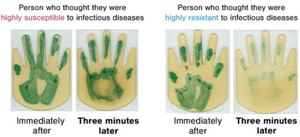
Figure 1:* Difference in the hand surface infection barrier of persons having high and low resistance to infectious diseases
-
* There was an error in the explanation of figure 1, modified on December 16, 2020.
Before:
Person who thought they were
highly resistant to infectious diseases
Person who thought they were
highly susceptible to infectious diseases
After:
Person who thought they were
highly susceptible to infectious diseases
Person who thought they were
highly resistant to infectious diseases
In this experiment, residual bacteria, which were applied to the volunteers' hands, were observed using the hand-stamp method immediately following the application and three minutes later (E. coli are colored green). The number of E. coli decreased significantly on the volunteers who thought they had high resistance to infectious diseases.
Then, surface compounds on the hands of six volunteers were collected to evaluate their antibacterial and antiviral activity. We could confirm that the surface compounds that existed on the volunteers' hands had an inactivating effect not only against E. coli but also Staphylococcus aureus and the influenza A virus (H3N2). It was also revealed that this inactivation effect varied among individuals: some individuals exhibited a strong inactivation effect on all bacteria and viruses, while other individuals showed the opposite pattern (Figure 2).
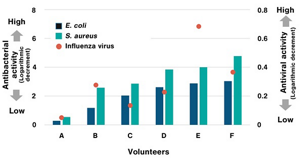
Figure 2: Antibacterial and antiviral activity of the surface compounds on the volunteers' hands
The researchers also conducted another study of 10 volunteers for a few days to observe how the antibacterial effect of the hand surface compounds changed during each day and also from day to day. The results revealed that the effect was rather consistent and permanent (Figure 3).
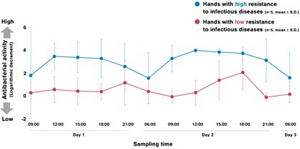
Figure 3: Change in the antibacterial activity of the hand surface components during each day and from day to day (against S. aureus)
Based on these findings, the researchers believe that the human hands are constitutively equipped with a function that reduces bacteria and viruses, and that it varies among individuals, with some people maintaining constantly high levels. Kao has named this function "hand surface infection barrier" and has been conducting further research on this topic.
(2) The study verified that the hand surface infection barrier positively affects resistance to infectious diseases based on quantitative data.
A pool of 109 healthy male and female volunteers aged between 20 and 49 were selected, of which 55 were known to have low resistance to infectious diseases, while 54 were known to have high resistance*4 . Then, samples on the surface of their hands were collected to evaluate their antibacterial activity. The study revealed that the samples from the volunteers with high resistance to infectious diseases had significantly high antibacterial activity against both E. coli and S. aureus (Figure 4). This finding strongly suggests that those volunteers' hand surface infection barrier had contributed to their resistance to infectious diseases.
-
* 4 "Low-resistance" individuals had caught influenza at least twice in the past three years, and had exhibited cold symptoms at least three times in the past year. Meanwhile, "high-resistance" individuals had not caught either a cold or influenza during the same periods.
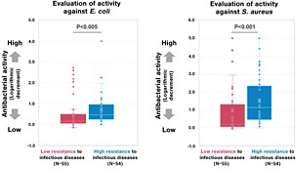
Figure 4: Correlation between resistance to infectious diseases and antibacterial activity of the hand surface samples
(3) The key factor of the hand surface infection barrier was lactic acid.
A pool of 54 male and female volunteers in their 20s to 40s were selected, and then samples of what were on the surface of their hands were collected for evaluation, in order to identify the compounds that were highly correlated to the antibacterial and antiviral activity against S. aureus and the influenza A virus (H3N2). The results showed that the lactic acid secreted from the hands was playing the key role in this activity (Figure 5), among the several compounds that had exhibited a high correlation to both pathogenic microorganisms.
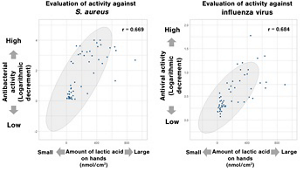
Figure 5: Relationship between the amount of lactic acid found on the hands and the level of antibacterial and antiviral activity of the hand surface samples
In another experiment where a lactic acid solution was applied to the volunteers' hands with varying amounts of lactic acid within the range that exists on human hands, it was confirmed that the antibacterial activity increased as the amount of lactic acid increased (Figure 6).
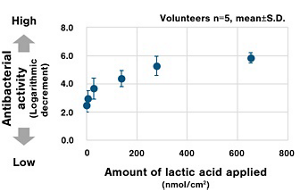
Figure 6: Change in antibacterial activity with application of lactic acid to the hands (against E. coli)
Future outlook
Conventional hand hygiene methods such as hand washing and alcohol-based hand sanitizers have only transient effects of removing and inactivating bacteria and viruses. In contrast, the characteristic of the inherent hand surface infection barrier function is that it is permanent. The discovery of this hand surface barrier could lead to new suggestions on hygiene behavior to enhance the inherent barrier function of the hands. In the future, Kao will continue its in-depth research on the hand surface infection barrier function and propose new hygiene behaviors in order to contribute to the realization of infection prevention behavior that will protect people around the world from various infectious diseases as well as from the distress they cause.
About Kao
Kao creates high-value-added products that enrich the lives of consumers around the world. Through its portfolio of over 20 leading brands such as Attack, Bioré, Goldwell, Jergens, John Frieda, Kanebo, Laurier, Merries and Molton Brown, Kao is part of the everyday lives of people in Asia, Oceania, North America and Europe. Combined with its chemical division, which contributes to a wide range of industries, Kao generates about 1,500 billion yen in annual sales. Kao employs about 33,000 people worldwide and has 130 years of history in innovation. Please visit the Kao Group website for updated information.
Media inquiries should be directed to:
Corporate Communications
Kao Corporation
